Solution
1.S*2b 2.Sx2b 3.+Rx4a 4.Kx4a 5.G*4b
1.S*2b 2.Sx2b 3.+Rx4a 4.Kx4a 5.G*4b
1.S*3a 2.K1b 3.N*2d 4.Px2d 5.B2a+ 6.Kx2a 7.L*2c 8.K1b 9.L2b+
1.S*3a 2.Gx3a 3.Nx2a+ 4.K1b 5.G*2b 6.Gx2b 7.+Nx2b 8.Kx2b 9.N*3d 10.K1b 11.G*2b
1.N*1c 2.Lx1c 3.G*1b 4.Gx1b 5.G*3b 6.K1a 7.+Bx1b 8.Kx1b 9.G*2b
Shogi game explained
(Text moves) 1.P2f 2.P8d 3.P2e 4.P8e 5.G7h 6.G3b
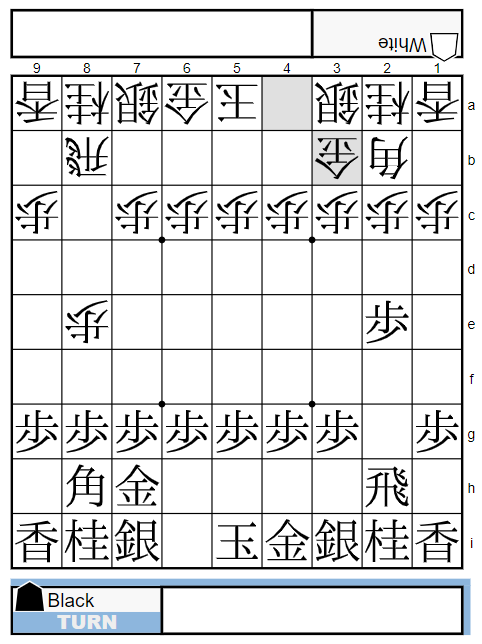
Double Wing Rook.
(Text moves) 7.P2d 8.Px2d 9.Rx2d 10.P*2c
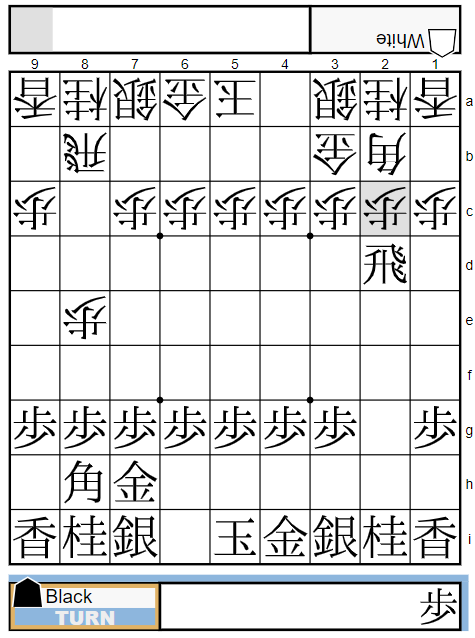
(Text moves) 11.R2h 12.P8f 13.Px8f 14.Rx8f 15.P*8g 16.R8d
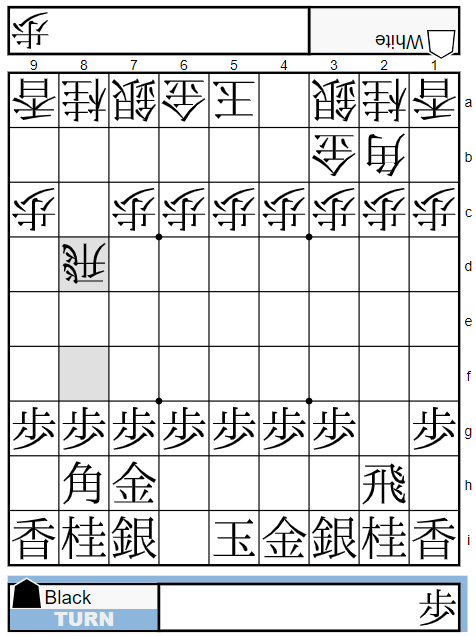
(Text moves) 17.S3h 18.S7b 19.P4f 20.S8c
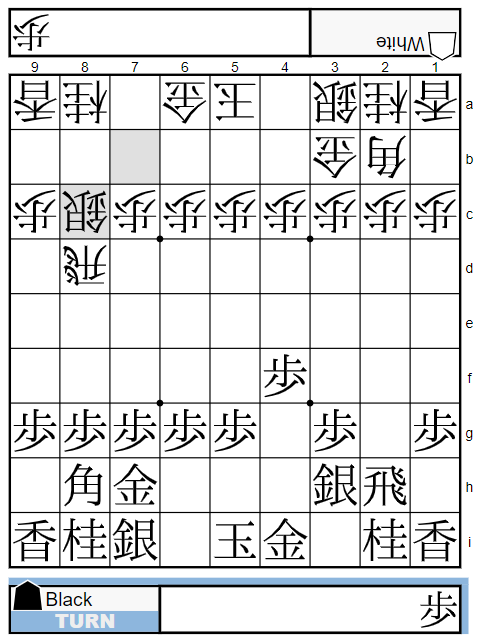
19.P4f: 19.S2g is perfectly playable.
20.S8c: aggressive move.
(Text moves) 21.P7f 22.S7d 23.P4e 24.S6e.

23.P4e: another option is 23.B6f and then, 24.R8b 25.N7g
24.S6e: if 24.S8e is played, 25.R2f 26.P*8f 27.Px8f 28.Sx8f 29.B6f
(Text moves) 25.R2f 26.S5d 27.P3f 28.P3d
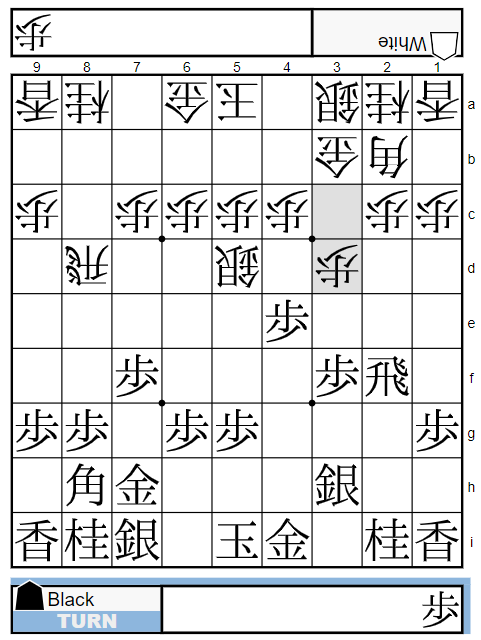
26.S5d: it turns out that White let Black play P4e on purpose and targets the Pawn on 4e.
27.P3f: 27.P4d is possible.
28.P3d: 28.Sx4e is possible.
(Text moves) 29.N3g 30.N3c 32.K6b 33.S4g 34.Nx4e
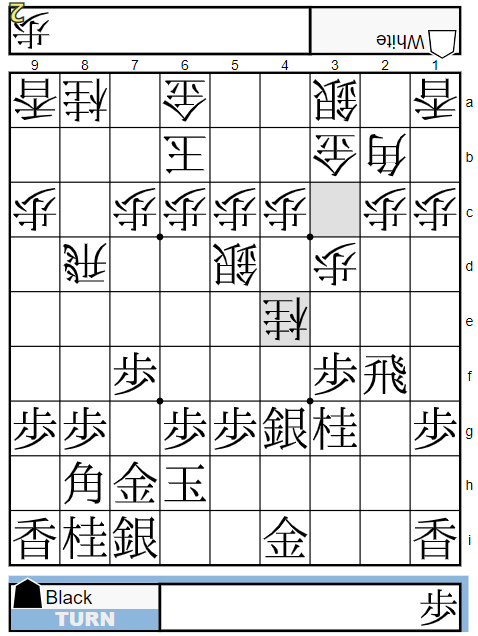
32.K6b: White gets the White King away from 3 files and 4 files. this opening is no longer in book.
34.Nx4e: White has no choice. White can’t play Nx4e after Black plays S5f.
(Text moves) 35.Nx4e 36.Sx4e 37.R2e 38.P3e
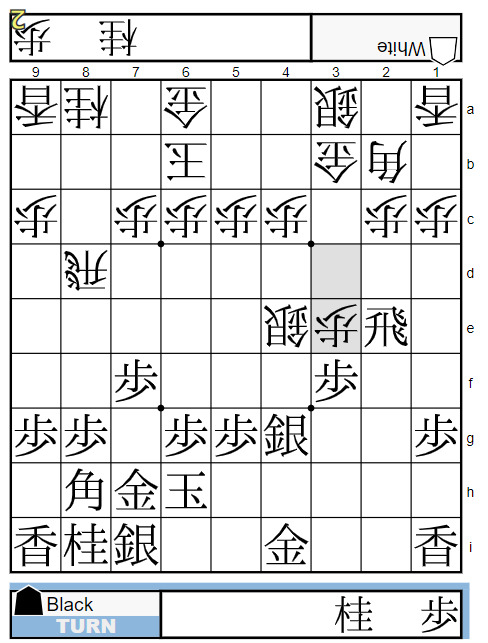
37.R2e: if White plays 38.S5d, Black would play 39.N*4f
38.P3e: if Black plays 39.Px3e, White would play 40.Bx8h+ 41.Sx8h 42.B*1d 43.R2g 44.N*1e 45.R3g 46.R2d
(Text moves) 39.Bx2b+ 40.Sx2b 41.Rx3e 42.S3d
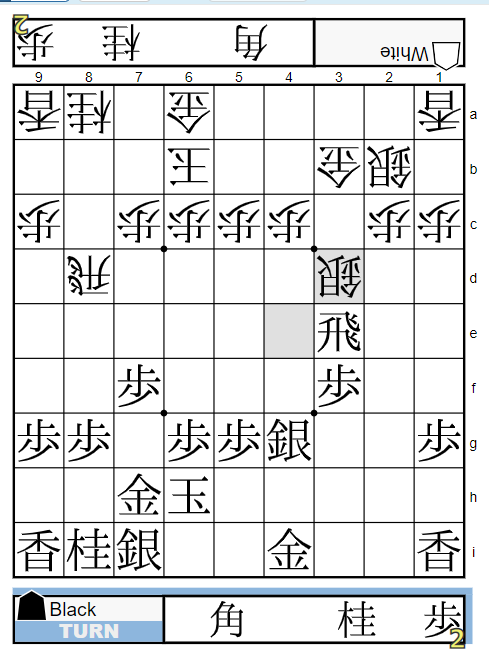
39.Bx2b+: 39.G3h is possible.
(Text moves) 43.B*6f 44.R6d 45.R8e 46.P*8d
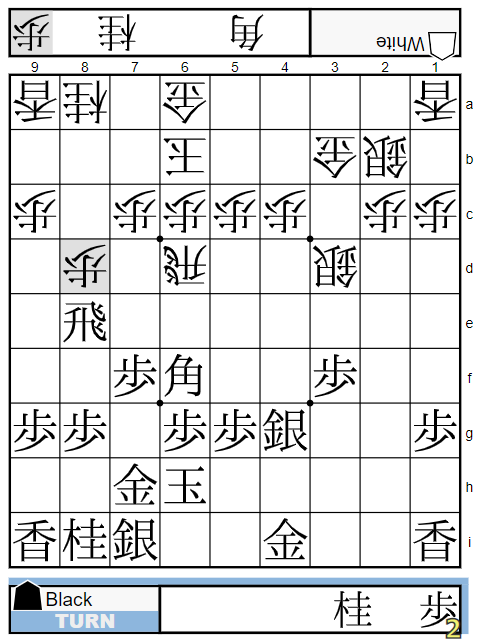
46.P*8d: if Black plays 47.Rx8d, White will play 48.B*9e
(Text moves) 47.R5e 48.B*3g 49.P*4f 50.P5d
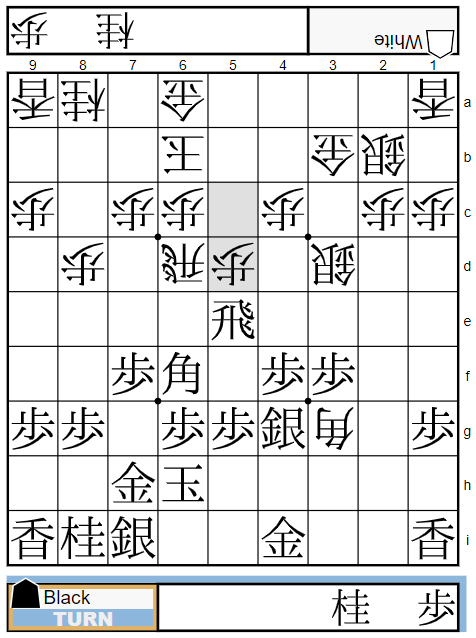
48.B*3g: threatens Rx6f
(Text moves) 51.R7e 52.P7d 53.Bx2b+ 54.Gx2b
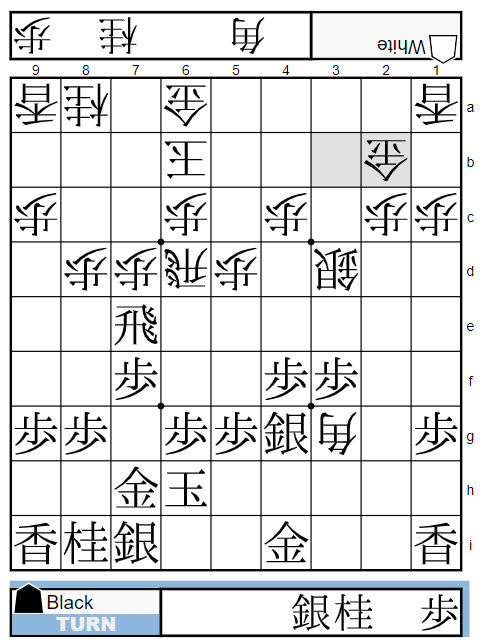
52.P7d: both Rooks are short on suquares.
53.Bx2b+: 53.R9e doesn’t work because 54.P9d
(Text moves) 55.N*5f 56.Px7e 57.Nx6d 58.Px6d
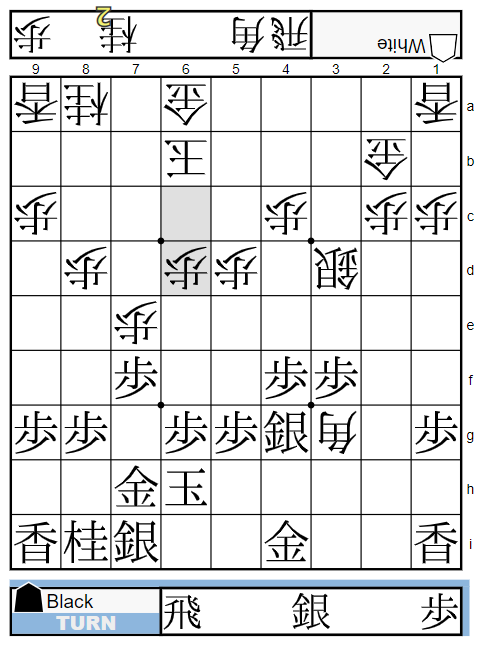
58.Px6d: White is much ahead in material.
(Text moves) 59.R*8b 60.B*7b 61.S*8c 62.K7a
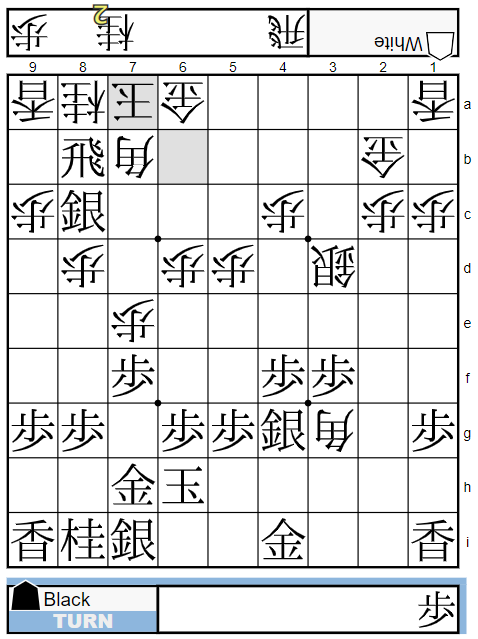
59.R*8b: other options are 59.R*3a and 59.R*4b
62.K7a: prevents Black from playing Sx7b+ Gx7b Rx8a+
(Text moves) 63.P3e 64.Sx3e 65.Rx7b+ 66.Gx7b
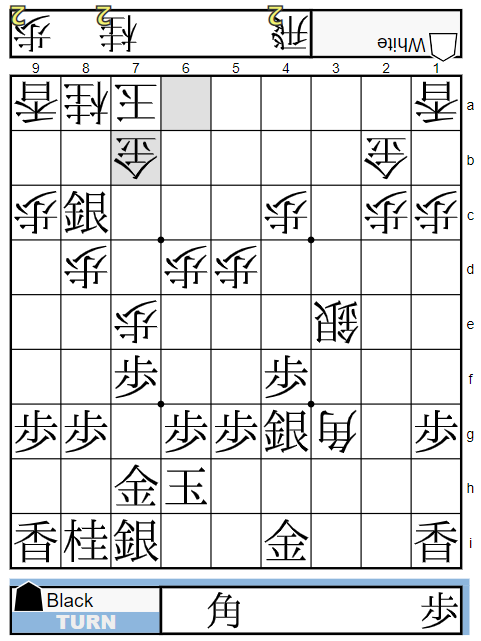
64.Sx3e: 64.S2e is better.
(Text moves) 67.B*5c 68.N*6b 69.Sx7b+ 70.Kx7b
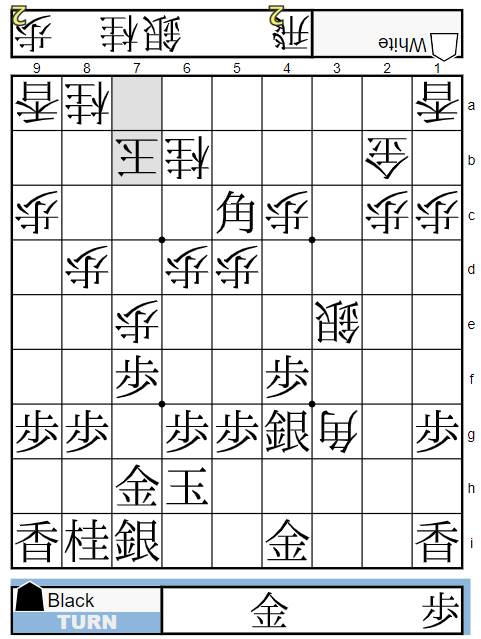
67.B*5c: attacks the King on 7a and the Silver on 3e.
(Text moves) 71.G*5b 72.R*2h 73.P*3h 74.B2f+
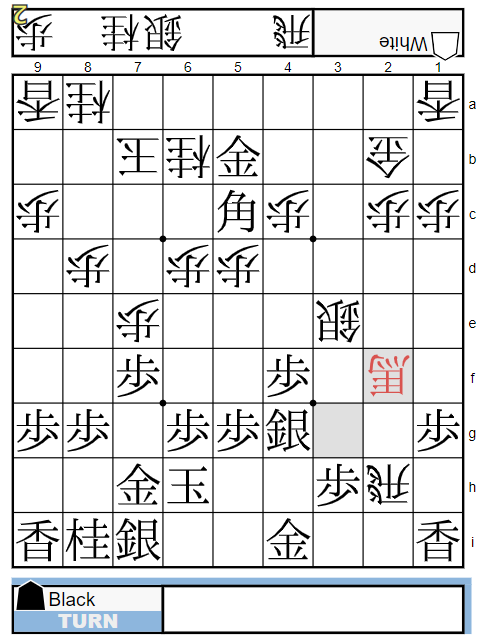
71.G*5b: 71.Bx3e is better.
72.R*2h: if Black plays 73.G3h, White would play 74.N*6e and Black can’t play 75.Gx2h because 76.S*5i 77.K6i 77.Nx5g 78.K5h 79.B4h+
(Text moves) 75.Bx6b+ 76.K8b 77.N*7d 78.K8c
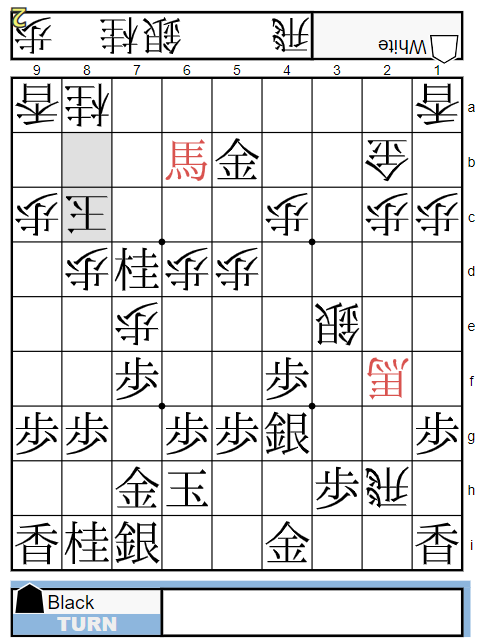
78.K8c: the White King is naked but Black is short in material.
(Text moves) 79.Px7e 80.R*2i 81.+B6a 82.S*7b
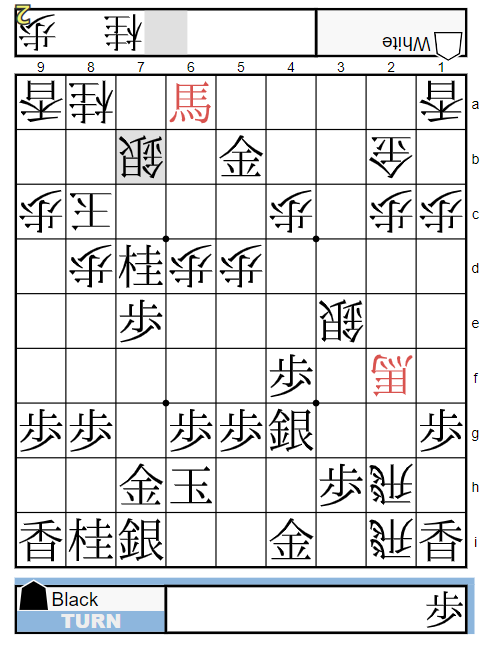
80.R*2i: 80.R2i+ is better.
82.S*7b: 82.P*7b is better.
(Text moves) 83.+B7a 84.S7c 85.S5h 86.K9b
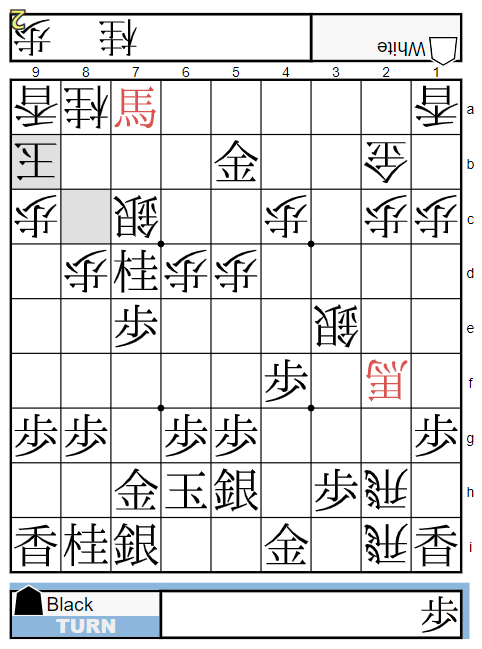
86.K9b: protects the Knight on 8a.
(Text moves) 87.G6b 88.Sx4f 89.G7g 90.N*6e 91.+B7b 92.Rx3h+ resign
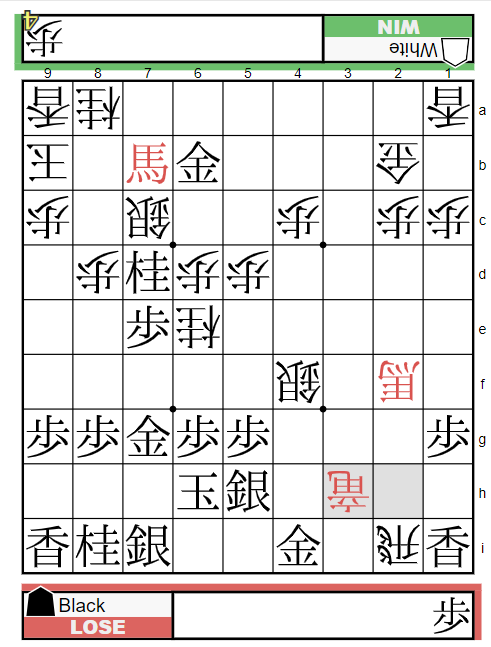
88.Sx46: opens up the 2g-promoted Bishop’s diagonal
92.Rx3h+: If Black plays 93.Gx3h, White will play 94.R5i+ or 94.+B5i.
Start
1: ☗P-2f
2: ☖P-8d
3: ☗P-2e
4: ☖P-8e
5: ☗G-7h
6: ☖G-3b
7: ☗P-2d
8: ☖Px2d
9: ☗Rx2d
10: ☖P2c 11: ☗R-2h 12: ☖P-8f 13: ☗Px8f 14: ☖Rx8f 15: ☗P8g
16: ☖R-8d
17: ☗S-3h
18: ☖S-7b
19: ☗P-4f
20: ☖S-8c
21: ☗P-7f
22: ☖S-7d
23: ☗P-4e
24: ☖S-6e
25: ☗R-2f
26: ☖S-5d
27: ☗P-3f
28: ☖P-3d
29: ☗N-3g
30: ☖N-3c
31: ☗K-6h
32: ☖K-6b
33: ☗S-4g
34: ☖Nx4e
35: ☗Nx4e
36: ☖Sx4e
37: ☗R-2e
38: ☖P-3e
39: ☗Bx2b+
40: ☖Sx2b
41: ☗Rx3e
42: ☖S-3d
43: ☗B6f 44: ☖R-6d 45: ☗R-8e 46: ☖P8d
47: ☗R-5e
48: ☖B3g 49: ☗P4f
50: ☖P-5d
51: ☗R-7e
52: ☖P-7d
53: ☗Bx2b+
54: ☖Gx2b
55: ☗N5f 56: ☖Px7e 57: ☗Nx6d 58: ☖Px6d 59: ☗R8b
60: ☖B7b 61: ☗S8c
62: ☖K-7a
63: ☗P-3e
64: ☖Sx3e
65: ☗Rx7b+
66: ☖Gx7b
67: ☗B5c 68: ☖N6b
69: ☗Sx7b+
70: ☖Kx7b
71: ☗G5b 72: ☖R2h
73: ☗P3h 74: ☖B-2f+ 75: ☗Bx6b+ 76: ☖K-8b 77: ☗N7d
78: ☖K-8c
79: ☗Px7e
80: ☖R2i 81: ☗+B-6a 82: ☖S7b
83: ☗+B-7a
84: ☖S-7c
85: ☗S-5h
86: ☖K-9b
87: ☗G-6b
88: ☖Sx4f
89: ☗G-7g
90: ☖N*6e
91: ☗+B-7b
92: ☖Rx3h+
93: ☗Resign
There are two main types of openings. Static Rook( 居飛車 Ibisya) is that using the Rook statically. You move R-Pawn to 2f-2e to activate the Rook. Ranging Rook(振り飛車 Furibisya) is that using the Rook on the left side. besides, they are divided into many openings.
Double Wing Attack(相掛り Aigakari): there are not many book moves relatively. you might tend to meet unfamiliar positions.
Side Pawn Picker(横歩取り Yokofudori): one of the most intense openings. there are many traps for each other. you could lose easily if you don’t know book moves.
Yagura(矢倉 Yagura): both sides can develop pieces well. it’s said that Yagura is the classic of Shogi.
Bishop Exchange(角換り Kakugawari): both sides have Bishops in hand from the beginning. you need to be careful not to let your opponent put the Bishop in your area.
Opposing Rook(向飛車 Mukaibisya): you can play this opening if your opponent plays P8e early. the purpose of this opening is that trying to counter-attack by playing P8f Px8f Bx8f(or Rx8f)
3rd-file Rook(三間飛車 Sankenbisya): it might be hard to play because it’s unclear how to use the Rook. the Rook guards the Bishop’s head indirectly.
Ishida Style(石田流 Isidaryu): it’s aggressive more than 3rd-file Rook. usually, this opening is for Black.
Masuda’s Ishida Style(升田式石田流 Masudashikiishidaryu): it’s hard to play because both sides have the Bishop in hand and the Black Rook is in the middle of rank.
4th-file Rook(四間飛車 Shikenbisya): it’s a popular opening for beginners because it’s easy to develop pieces and you can activate your Rook and Bishop at the same time when you play P6e. the downside is that you tend to be passive.
Central Rook(中飛車 Nakabisya): it’s hard to play because the left Gold tends to go to the left side.
Gokigen Central Rook(ゴキゲン中飛車 Gokigennakabisya): it’s aggressive more than Central Rook. it is named after a professional Shogi player, Masakazu Kondou 6Dan, who won many matches with it in 2004 and was always cheerful (cheerful means “Gokigen” in Japanese)
Double Ranging Rook(相振り飛車 Aifuribisya): you need to come up with how to develop pieces because this opening tends to be out of book.
1.B*1c 2.Nx1c 3.G*2a 4.Kx2a 5.G*2b
1.S*4b 2.Sx4b 3.S*3b
in this odds game, you will learn how to attack the edge.
(Text moves) 1.G7b 2.P7f 3.K4b 4.B6f
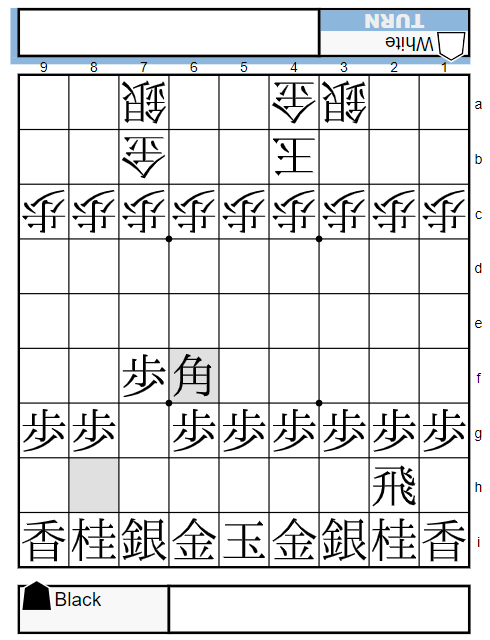
4.B6f threatens Bx9c+
(Text moves) 5.S8b 6.P9f 7.P7d 8.P9e 9.P6d 10.P5f
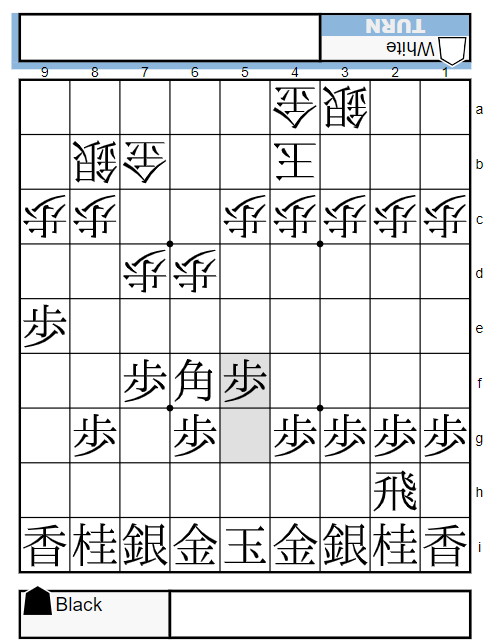
6.P9f and 8.P9e activate the Lance on 9i.
10.P5f makes room for the Bishop to go to 5g-square if White plays P6e.
10.P9d doesn’t work because 11.Px9d 12.Lx9d 13.P6e 14.B7g 15.P*9c and Black will lose material.
Black wants to keep the Bishop’s diagonal to 9c-square.
(Text moves) 11.K3b 12.P9d 13.Px9d 14.Lx9d
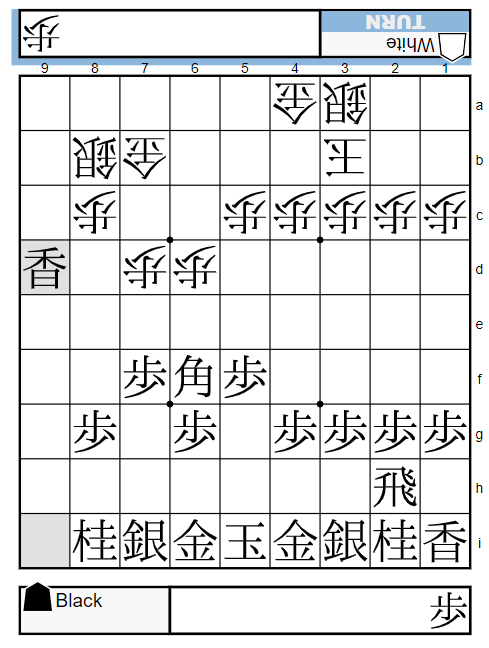
(Text moves) 15.P8d 16. R9h
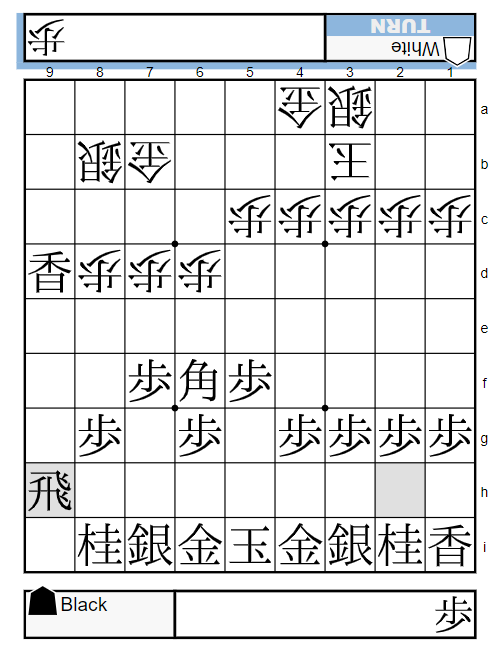
15.P8d is a poisoned Pawn. if Black plays 16.Bx8d, White’d play 17.G8c(or 17.S8c 18.B9c+ 19.P*9b ) 18.B6b+ 19.Gx9d. 16.L9b+ is possible.
16.R9h is important. don’t let your Rook out of play.
(Text moves) 17.S7c 18.L9b+ 19.S4b 20. +L8a
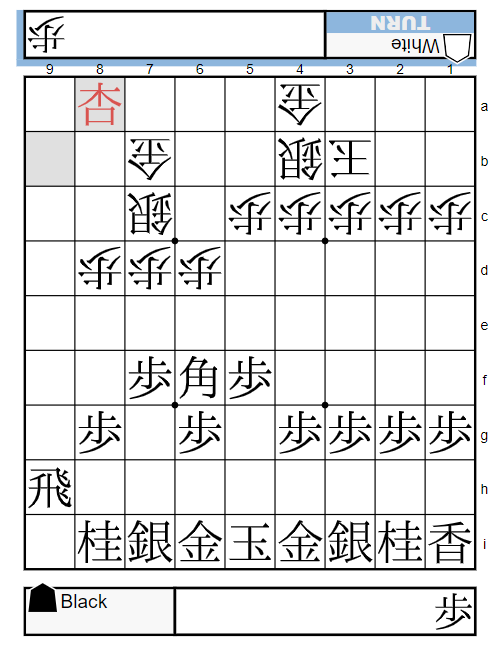
18.L9a+ is playable and if White plays 19.G8b, Black can play 20.+L9b(20.P*9c is possible)21.G7b(21.G8c 22.+L9c) 22.+L8a
(Text moves) 21.G6c 22.R9b+ 23.P6e 24.B5g 25.K2b 26.P1f 27.G3b 28.P1e
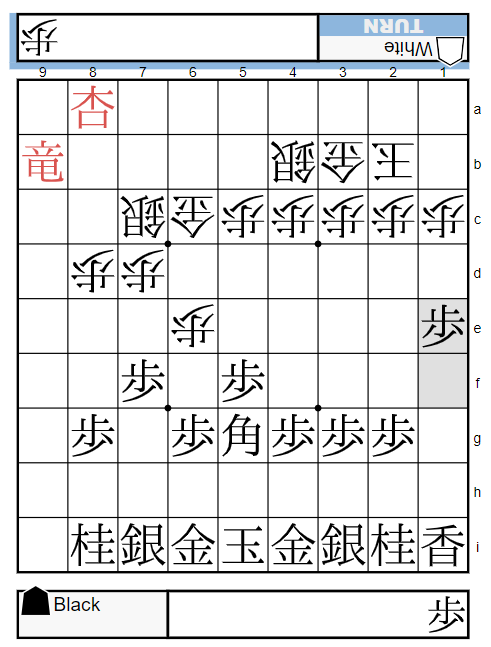
Black is successful with 22.R9b+
26.+L7a is possible. it threatens +L7b S6d +L6b
now you can see that White can’t defend the edge with one Silver, but what if White could defend with 2 defenders? let’s go back to diagram 2
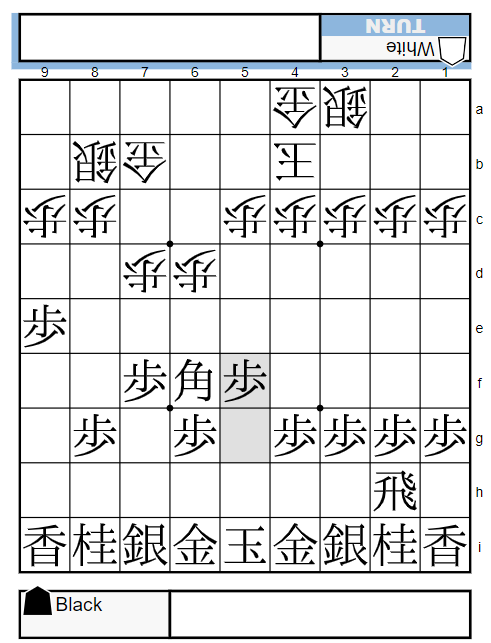
(Text moves) 11.G7c 12.P9d 13.Px9d 14.Lx9d 15.G8d
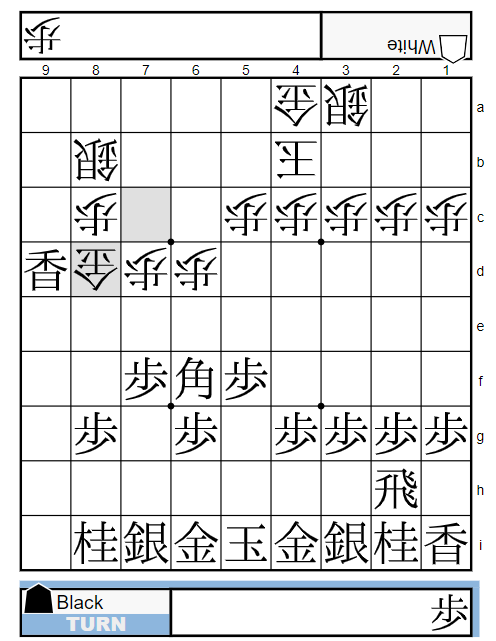
15.G8d blocks Bishop’s diagonal and threatens to caputure the Lance on 9d
(Text moves) 16.R9h 17.P*9e
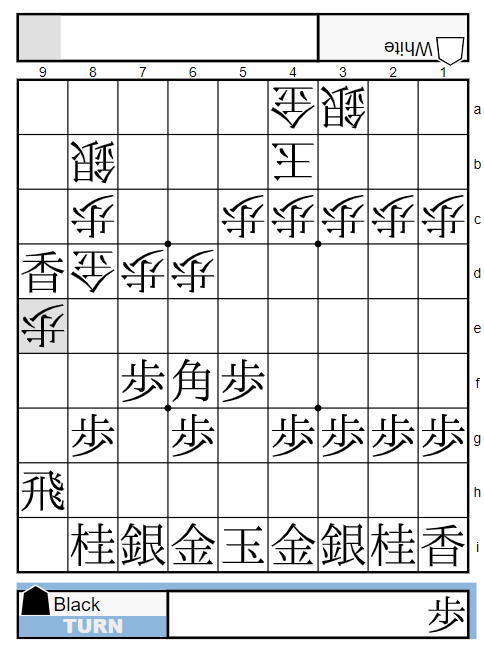
17.P*9e: thanks to the Gold on 8d,White can block the Rook.
(Text moves) 18.Bx8d 19.Px8d 20.Rx9e
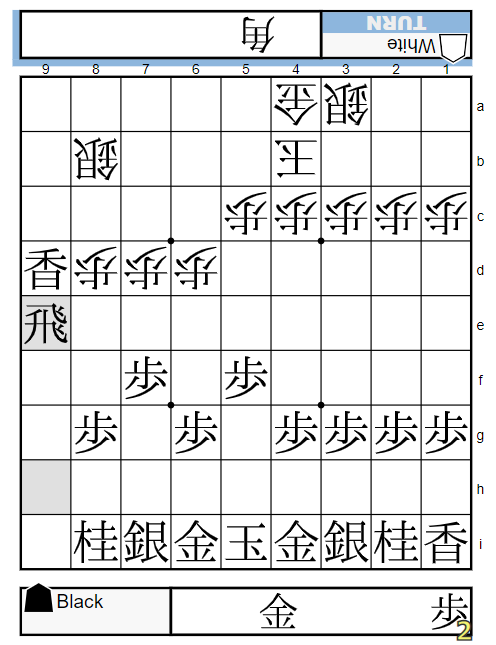
18.Bx8d: it’s really hard to play even though it’s a book move. some people fail with 18.L9b+ 19.S7c 20.Bx8d 21.Sx8d and Black can’t play Rx9e. the move order is very important here. Black is behind in material but the compensation of Rook promotion is big.
(Text moves) 21.S7c 22.L9c+ 23.S6b 24.+L8c 25.S5a 26.R9b+
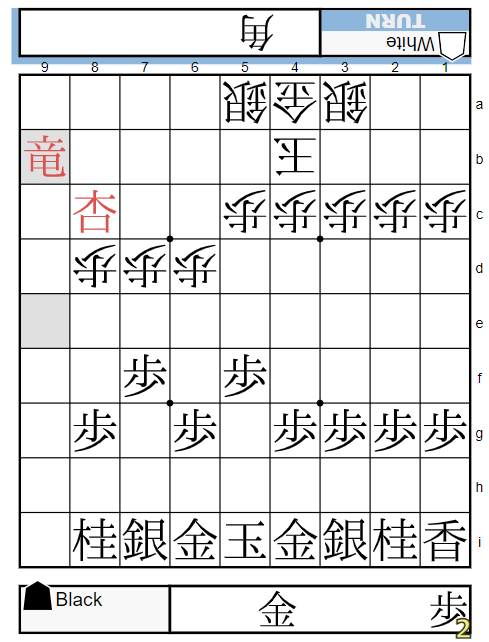
9c- Silver escapes and makes himself useful.
(Text moves) 27.G5b 28.+L7c
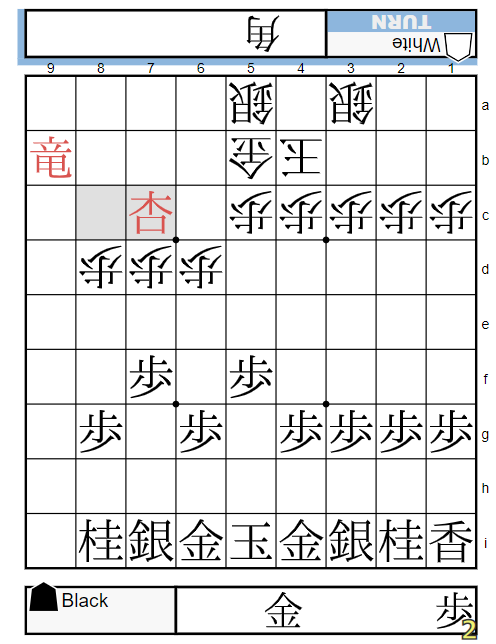
28.+L7c threatens +L6c
(Text moves) 29.B*5d 30.S3h
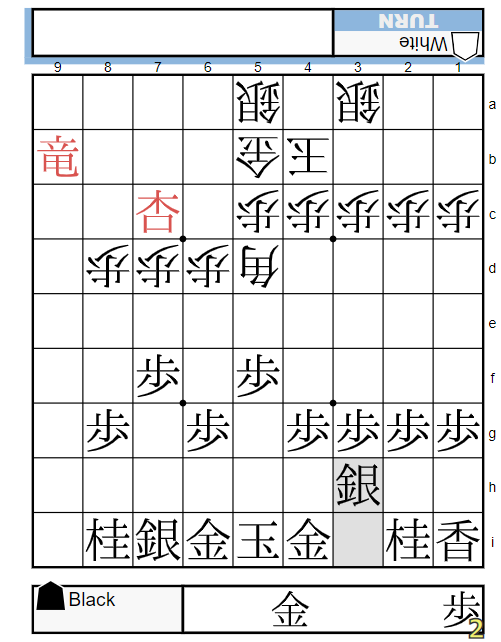
29.B*5d threatens Bx2g+ and guards 6c-square
(Text moves) 31.P3d 32.P5e 33.Bx7g 34.G7h
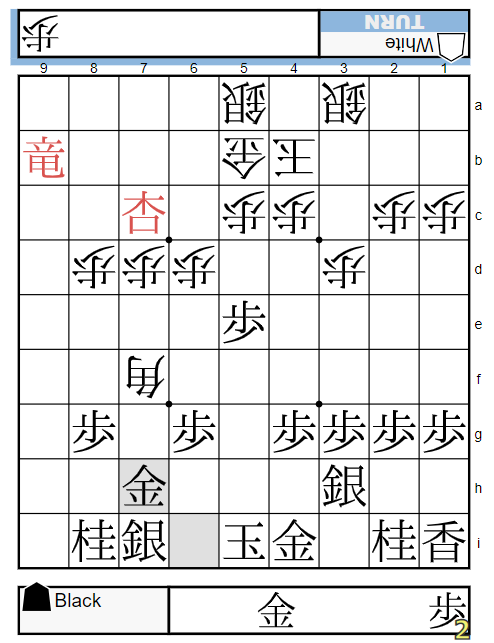
there’re not good moves for White. Black threatens +L6c and G*6f
Start
1: ☖G-7b
2: ☗P-7f
3: ☖K-4b
4: ☗B-6f
5: ☖S-8b
6: ☗P-9f
7: ☖P-7d
8: ☗P-9e
9: ☖P-6d
10: ☗P-5f
11: ☖K-3b
12: ☗P-9d
13: ☖Px9d
14: ☗Lx9d
15: ☖P-8d
16: ☗R-9h
17: ☖S-7c
18: ☗L-9b+
19: ☖S-4b
20: ☗+L-8a
21: ☖G-6c
22: ☗R-9b+
23: ☖P-6e
24: ☗B-5g
25: ☖K-2b
26: ☗P-1f
27: ☖G-3b
28: ☗P-1e
Start
1: ☖G-7b
2: ☗P-7f
3: ☖K-4b
4: ☗B-6f
5: ☖S-8b
6: ☗P-9f
7: ☖P-7d
8: ☗P-9e
9: ☖P-6d
10: ☗P-5f
11: ☖G-7c
12: ☗P-9d
13: ☖Px9d
14: ☗Lx9d
15: ☖G-8d
16: ☗R-9h
17: ☖P9e 18: ☗Bx8d 19: ☖Px8d 20: ☗Rx9e 21: ☖S-7c 22: ☗L-9c+ 23: ☖S-6b 24: ☗+L-8c 25: ☖S-5a 26: ☗R-9b+ 27: ☖G-5b 28: ☗+L-7c 29: ☖B5d
30: ☗S-3h
31: ☖P-3d
32: ☗P-5e
33: ☖Bx7f
34: ☗G-7h
1.Sx1a+ 2.Kx1a 3.L*1c 4.K2a 5.R1b+ 6.K3a 7.N*4c